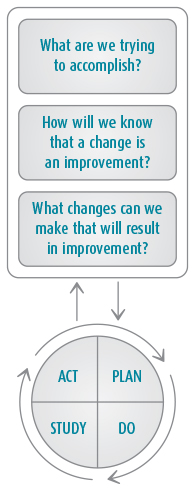
Ensuring and improving the quality of health care services, including dental services, is built into the IHS mission of raising “the physical, mental, social and spiritual health of American Indians and Alaska Natives to the highest level,” according to CAPT Timothy Ricks, Deputy Director of the IHS Division of Oral Health (DOH).
Dr. Ricks notes that IHS dentists maintain the standards of a high-quality dental program through a robust continuing dental education program that awarded more than $7.2 million worth of training last year through 245 different courses.
Many IHS dentists have learned basic quality improvement principles through IHS’ Improving Patient Care (IPC) program, which teaches a quality improvement methodology called the Model for Improvement, developed by the Associates in Process Improvement. In this model, three basic questions are asked:
- What are we trying to accomplish?
- How will we know whether a change is an improvement?
- What changes can we make that will result in improvement?
Dr. Ricks says this model is used on a daily basis in many of the 404 IHS, Tribal and Urban Indian dental programs to improve the delivery of care to patients and test changes using the Plan-Do-Study-Act (PDSA) cycle.
Examples of PDSAs performed routinely by dentists include testing proposed ways to improve sealant retention, broken appointment rate reduction procedures, patient compliance with dental instructions, endodontic therapy success, post-surgical complication reduction and others.
On its own, DOH has established numerical standards for quality of care issues that can be measured, says Dr. Ricks. These include evaluation of measures such as services per patient visit, the proportion of patients receiving dental exams, the proportion of patients completing planned treatment, broken appointment rates and other measures.
Regional dental leadership, called Area Dental Officers, in conjunction with DOH, conduct comprehensive program reviews routinely in IHS, Tribal and Urban dental programs to evaluate quality issues such as credentialing and privileging, chart documentation, infection control, hazard communications, radiology safety, local clinic policies and protocols, the local dental quality improvement program, employee development, prevention projects and clinical efficiency and productivity.
When you join DOH as a dental professional, you can be assured that you’re part of an organization that provides the best care for our patients — and sustained, continuous quality improvement is one of the ways we accomplish our mission!
Browse our list of current openings! |








